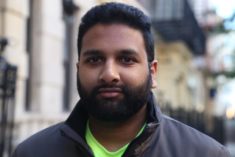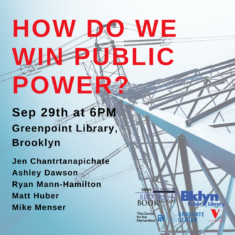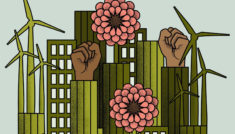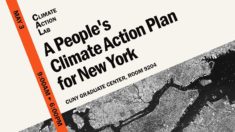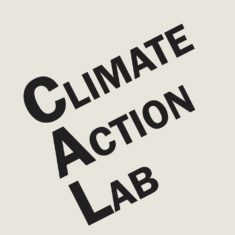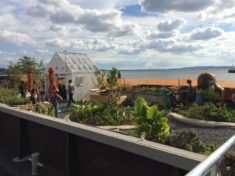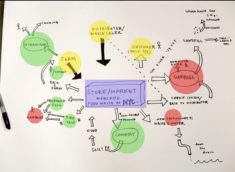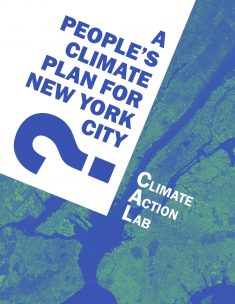Energy Sovereignty in New York City and Beyond
The thematic focus for this month's Climate Action Lab (CAL) session was political struggles around the economies and infrastructures of energy systems at urban, national, and planetary scales. The session featured remarks by artist Marina Zurkow, artist, writer and organizer Subhankar Banerjee, and Kartik Amarnath, energy planner for the New York City Environmental Justice Alliance.
The session was shadowed by the release a week and half earlier by the IPCC's so-called "doomsday report," a document originally commissioned by the governments of low-lying Pacific Islands, for whom global warming is a real-time disaster with life and death stakes. As CAL director Ashley Dawson noted in his introductory remarks to the session, the report is striking in the fact that is the most urgent call yet sounded by the mainstream of climate scientists about the need to immediately begin a transition away from fossil-fuel capitalist development. Given the climate recalcitrance and even nihilism of the Trump regime, the federal government is not for the time being going to be a proactive agent of de-carbonization. However, state and urban governments around the country are taking a kind of lead, including in New York. Unfortunately, however, the policy initiatives currently put forward by the putative vanguard of the green economy by figures like Andrew Cuomo and Bill de Blasio remain woefully beholden to neoliberal market solutions that leave fundamental mechanisms of capitalist growth intact and lack an emphasis on comprehensive environmental justice. These neoliberal approaches to energy transition are exemplified by NY Reforming the Energy Vision (REV). However, the high-profile acknowledgement of the need for a shift in energy infrastructure has nevertheless provided an opportunity for leveraging and response by environmental justice groups. Yet even these alternatives emerging from the progressive NGO sector like New York Renews, however, have remained fairly modest in their demands when compared to the emergency declaration by the IPCC report. How might grassroots organizers, researchers, and artists combine their skill sets to escalate the ambition of urban climate initiatives in line with the alarm-bells being sounded by scientists and frontline communities that are already immersed in the crisis, from the South Pacific to Arctic Alaska? How might the speculative climate imaginaries of artists and the research initiatives of scholars productively synergize with the visionary projects and nut-and-bolts policy work being advanced at the grassroots level?
Marina Zurkow presented a series of collaborative artistic and design experiments exploring the nexus between food, energy, and climate change in economic, cultural, affective, and aesthetic terms. Zurkow began by acknowledging that some of the projects in question have, quite rightly in her estimation, been questioned for their apparently "bourgeoise" qualities in terms of their formats and constituencies, thus far largely confined to participants in academic and artistic spaces. Avowing that the work aims to be "activating" for its audience rather than "activist" in the sense of advocating a particular program, Zurkow framed her projects in terms of experimental "engagement techniques" for stimulating collective dialogue about climate crisis as it interfaces with most elemental energy-process which organic life depends: the metabolic process of eating. Drawing on Donna Haraway's etymology of "companion" ("breaking bread with"), Zurkow is interested in: "Who is at the table, how we eat, with whom we eat, and what we eat."
Among the projects described by Zurkow were Future Topophagies, which involved a two-day participatory workshop in Minneapolis wherein participants were invited to imagine and design "the picnics of the future" based on assorted collections of apparently random objects distributed to them. Rather than a scenario in which participants freely imagine a beautiful ecological future, the objects were intended to act as constraints to the design process, resulting in an array of variously dystopian and/or creatively resourceful solutions to food production, distribution, and consumption under conditions of duress.
Another project took place in Rice University, in Houston, a Gulf Coast city whose social fabric continues to be marked by the Deepwater Horizon disaster of the mid-2000s. This project involved a meal/performance wherein the courses were intended to thematize "eating your way through deep time," i.e. the geological time-scale of ancient organisms becoming petroleum, and in turn becoming part of the modern fossil fuel capitalist system and its attendant ecological crises. Of particular note was the course of the meal focused on jellyfish, which, as a result of the destruction of local fisheries during the oil spill, have ended up becoming a dominant marine organism in the area with great nutritional and culinary potential that has thus far been appreciated by a relatively specialized niche market of companies oriented toward Asian and Asian-American markets. Other projects presented by Zurkow also focused on the tension between food traditions and identities, on the one hand, and the imperative of adjustment and innovation on the other in the face of climate crisis. (along with jellyfish, mollusks, and seaweed, goats are another underappreciated--and ethnically segregated--food source, Zurkow mentioned). One project focused on the development of Jellyfish Jerky that would be seasoned in ways connected to different climate-vulnerable areas of the world ranging from Fiji to the Netherlands.
Finally, Zurkow presented a participatory event wherein people at an art festival were invited to performatively eulogize "the human species" from the perspective of nonhuman beings, living and otherwise. This project raised the question of what it means to aesthetically conjure the "human species" as a universal entity at risk of extinction rather than a variegated condition of uneven ecological vulnerability and economic oppression related to global histories of colonialism, racialization, and extraction.
Fresh from having performed an interview with Amy Goodman on Democracy Now! about the Trump administration's authorization of the first full-fledged extraction efforts in the Alaskan National Wildlife Refuge (ANWR), Subhankar Banerjee presented his multifaceted work as an artist, writer, organizer and teacher who for the past two decades has focused on the Alaskan Arctic. This region is both a central terrain for petrocapitalist extraction in its own right, as well as a frontline area for the most immediate effects of fossil-fuel-induced climate change for frontline indigenous communities.
Banerjee began his presentation by noting that the Arctic is an essential "integrator" of the planetary climate equilibrium, and that conditions on the ground and in the atmosphere of this region have become far more volatile than suggested by the planetary aggregate of a 1.5 centigrade of warming invoked in the ICPP report. Conditions in some parts of the Arctic in recent years have been dozens of degrees higher than average, while others have been dozens of degrees colder. In other words, severe disequilibria are at work in this most sensitive bellwether region of the planet.
After this preface, Banerjee then retraced his work concerning global warming in the Arctic, with a particular focus on the alarms that have been sounded for two decades by indigenous activists and scholars in the region. If, in the early 2000s, global warming was seen by many outside of frontline zones like the Arctic as a distant or even debatable scenario, by 2018, every part of the planet is now experiencing it and there is an unequivocal scientific consensus surrounding it.
The narrative of the Trump regime has been to make America "energy dominant," the pathway to which is through the Arctic, where the Trump administration has now authorized what Banerjee called "petrocapitalism on steroids." However, throughout his presentation, Banerjee reminded his audience that it was the Obama administration that laid the groundwork for this new round of extractivism in the Arctic region. Trump however, has facilitated what is now the first actual oil and gas production taking place in the Arctic National Wildlife Refuge, which was the occasion for his appearance on Amy Goodman that morning. These developments constitute what Banerjee called "an epic ecocide and an epic ethnocide," devastating both the human communities of the region and the nonhuman biosphere with which they are intimately entwined. To take one example, Banerjee discussed the fate of the massive caribou population of the region, and the ways in which extractivism puts at risk the "nutritional, cultural, and spiritual dependencies" of native communities with these migratory creatures.
Banerjee then outlined a dynamic array of projects he has been involved in over the two years of the Trump regime, including advocacy-oriented academic conferences in both Alaska and New Mexico (where he himself teaches), publications, scholarly mobilizations, grassroots protests, and legal campaigns. In particular, he discussed his own approach to multi-species justice as outlined in the journal Social Text, grounded in the praxis of the group Defend the Sacred, a coalition led by young indigenous women in Alaska that, along with Fairbanks Climate Action Coalition, is the driving force of frontlines climate justice organizing in Alaska. Banerjee elaborated on the challenges that climate-conscious activists, scholars, and legislators face in Alaska, which he described as a "petro state" on par with Saudi Arabia. Speaking out against fossil capitalism can be not just an uphill battle but an outright risk, making the work of groups like Defend the Sacred all the more impressive in its vision and tenacity. He also described the importance of legal battles as sphere of action, and alluded with some discretion to the prospect of forthcoming lawsuits that might take the concept of "inter-governmental" dispute between native governments and the US government as a frame of accountability.
Finally, Banerjee made reference to a forthcoming project about the matter of species-extinction in three different geographical contexts, motivated by the question of "how to make exception into a public crisis" through its "spatial, temporal, and emotional dimensions."
Amarnath introduced himself as the energy planner for the New York City Environmental Justice Alliance (NYC-JEA). He began by recounting the analysis, motives, and tactics of the alliance. NYC-JEA is a city-wide coalition of grassroots organizations that serve New York City's most environmentally overburdened communities as a policy and advocacy shop for the movement. Following nation-wide patterns of environmental injustice, those communities who are most overburdened and vulnerable to environmental risk are disproportionately low-income communities of color. These patterns have structural underpinnings that traverse and connect specific local conditions.
Amaranth framed his introduction as "an epistemic argument about how we can see and know the city in the context of climate change," shedding light on the work of NYC-JEA as a form of "urban practice" facilitating a way of seeing and knowing amenable to fundamental transformation of the urban environment. Throughout the talk, he emphasized knowledge production grounded in local, experiential conditions as being entwined with transformative praxis.
Reinforcing the points made by Mychal Johnson of Sustainable South Bronx in the first meeting of CAL, Amaranth outlined the geographical layering of race, class, and environmental inequities with reference to the siting of SIMAs (Significant Industrial Maritime Areas) in the areas where the constituent groups of NYEJA are located. These are places zoned for heavy industrial use that are disproportionately overlaid with five factors: 1) toxic industries; 2) concentrations of racialized poverty; 2) flood vulnerability; 4) heat vulnerability; 5) gentrification and displacement. In particular, he homed in on Williamsburg/Bushwick as a place designated by Con-Edison as being subject to "energy shortfall," i.e. inadequate energy infrastructure to provide enough electricity in the event of severe heat or cold conditions.
Every year, NYC-EJA releases an analysis and policy document called the NYC Climate Justice Agenda that provides critical recommendations to city agencies that are in in principle tasked with addressing environmental and economic inequalities. Citing Chantal Mouffe, Amaranth emphasized the importance of a conflictual and agonistic relation between grassroots groups and the agencies they target with proactive demands, and the ways in which an adversarial stance can oftentimes help to support sympathetic actors within city agencies in their work of advancing progressive agendas. At the same time, despite its engagement with inside actors, NYC-EJA is in no way beholden to any governing institutions, and the other side of its tactical repertoire is what Amaranth described as "shutting shit down" through marches, demonstrations, and direct actions in tandem with the demands and priorities of the Climate Justice Agenda.
Amaranth then pivoted to a detailed discussion of energy politics in an urban frame, set against the backdrop of NYC-EJA's critique of Cuomo’s REV policy. Elaborating on the point made by Dawson at the beginning of the session, Amaranth explained that the market-based regulatory framework of REV in its historic uptake of clean energy transition for New York State fails to take into account historical legacies of oppression and distributions of vulnerability. Nevertheless, NYC-EJA has attempted to leverage the momentum and visibility around Cuomo's initiative in order to amplify an alternative framework under the rubric of a "Just Transition to a regenerative economy.” Amarnath noted that even at the supposed cutting edge of the green economy, historical structures of oppression and marginalization are reproduced as a default, and must be actively combatted in the name of energy democracy.
Four main points make up this alternative horizon:
1) Community ownership of energy resources: According to Amaranth, racial and economic justice can be understood as being built through the democratization of energy assets and infrastructures. The actual apparatus of energy, the economic processes of it, and the ideologies surrounding it are essential sites of struggle for justice and equity, including matters not only of the distribution of of energy per se but also employment in emerging alternative energy sector, which has been woefully uneven in terms of accessibility and mobility for communities of color and women of color in particular. Amaranth also emphasized here the difference between "conventional solar" as s sector, and "community solar" as a collectivized model of producing, storing, distributing, and profiting from energy resources.
2) Inclusive financing: deploying capital in ways that address historical patterns of disinvestment and neglect.
3) Supply Hubs for regional resiliency needs: This involves looking to SIMAs not just as sites of negative risk and pollution (and more recently, luxury development) but also as places with potential for building an inclusive infrastructure for a renewables economy at every level from jobs-intensive fabrication of equipment, to the siting and maintenance of renewable stations. Thus retaining the industrial profile of places like Industry City in Sunset Park could be potentially redirected toward a climate justice agenda that would in turn help to defend against luxury-oriented development and the resulting dynamics of displacement.
4) Proactive targeting of the oldest and most hazardous fossil-fueled plants in the state that have both deleterious impact on local populations (and beyond that, the planetary climate) as well as present risks in terms of flood vulnerability, as in the South Bronx.
Amaranth then returned to the details of the "energy shortfall" in Williamsburg/Bushwick, and explained the details of how Con-Ed has attempted to address the situation without having to build a whole new substation in the area. Their initiatives have been entirely directed to commercial and industrial entities, and has neglected residential structures, which could be potentially dynamic places for a pilot program of self-financing sustainable energy. NYC-EJA advocated for a relatively small amount of Con-Eds budget for the area to be directed to such a project, to no avail.
Amaranth ended his remarks by re-emphasizing that the work of NYC-EJA involves the overlapping of various forms of knowldges production (including policy reports, data sets, GIS maps), but that it is all ultimately grounded in, driven by, and accountable to the local, experiential knowledge of its membership organizations on the frontlines of both environmental injustice conditions and the and proactive envisioning of alternatives. And also, as he quipped at the very end: "shutting shit down."
The question and answer section of this session [included in detail in the transcript below] including discussions of the following points:
1) The difference between conventional and community solar energy systems.
2) How, if at all, the renewable energy sector has addressed critiques of its often exclusionary nature in terms of access to people of color and women (the Solar Foundation being an important source for this assessment).
3) How, if at all, calls by groups like the DSA to "socialize" large-scale energy grids in small states like Rhode Island might be transposed to New York.
4) The politics of "food cultures" in relation to the need for food/energy transition as discussed by Zurkow, including the factor of ethnically discriminatory biases against foods like goat.
5) How climate justice alliances are constructed, communicated, imagined across different sectors and groups, in terms of geography, culture, class, and institutional structures.



Co-sponsored by the Art, Activism, and the Environment research group as part of the Seminar on Public Engagement and Collaborative Research from the Center for the Humanities at the Graduate Center, CUNY; the Occupy Climate Change! Project of the Environmental Humanities Lab at the Royal Technology Institute of Sweden; and the Climate Action Research Cluster of the Social Text Collective.

